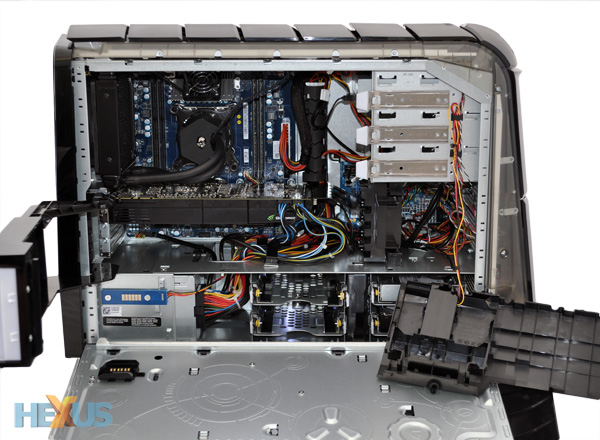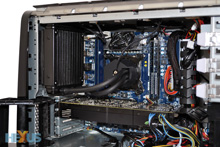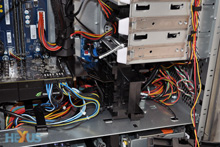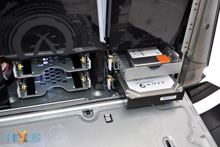Inside the Aurora R4
If you've enjoyed the Aurora R4's sci-fi styling, you'll appreciate the fact that the system's internal area is decorated with symbols and graphics of an alien nature. It looks cool, and the glossy-black plastic shrouds covering various sections of the PC give the system a clean and uncluttered feel.
Alienware's using a proprietary micro-ATX X79 motherboard, and it provides sufficient room for various high-end components. The Intel Sandy Bridge Extreme processor is flanked by quad-channel memory, there are three 5.25in optical drive bays, and four side-facing hard-disk bays that are easily accessed for storage upgrades.

The general layout is good, but the tight confines of a mid-tower chassis limit the Aurora to just four expansion slots. That of course allows for dual-GPU configurations, but if you opt to take that route, you'd leave no room for further expansion, and there are others limiations on the GPU front, too. At the time of writing, the Aurora R4 is available with either one of four single graphics cards (Radeon HD 6870, GeForce GTX 560 Ti, Radeon HD 6950 or GeForce GTX 580), or a choice of two dual-GPU configurations (two Radeon HD 6870s or two Radeon HD 6950s).
Not a bad selection by any means, and a single GTX 580 or two Radeon HD 6950s should provide ample power for full-HD gaming, but a high-end machine such as this deserves more. The close proximity of both graphics cards might be preventing Dell from introducing more exotic dual-GPU solutions (or indeed the limiations imposed by the standard 875W power supply), but no gaming rig should be without AMD's latest Radeon HD 7970 as an option. That's an oversight we hope to see rectified sooner rather than later.
The CPU, meanwhile, is cooled by an Asetek-produced liquid cooler, and in addition to the 120mm fan attached to the radiator, there are a couple of fans strategically positioned throughout the chassis. Dell's using a pair of small on-board fans to cool the motherboard's CPU VRM and chipset, there's another fan drawing air over the graphics card, and one final fan sandwiched vertically between the four hard-drive bays.
All looks neat and tidy, but removing some of the plastic covers reveals more clutter behind the scenes.

With this amount of wiring, we'd liked to have seen Dell use cable sleeves, and an all-black interior wouldn't have gone amiss, either. These omissions suggest that the Aurora isn't quite as well-engineered as it's made out to be, and there's evidence of that elsewhere, too. The pre-installed 1,600MHz DDR3 memory, for example, is without heatsinks and offers lacklustre timings of 11-11-11-28, and the up to 4.1GHz overclock on the Core i7-3930K processor? Dell charges an extra £100 for the privelage, but on our test system the advertised 4.1GHz speed was applied to only one of the CPU's six cores - the other five cores were overclocked to 3.8GHz.
The cost of available upgrades is also a concern. Going from 8GB (4x2GB) of memory to 16GB of memory (4x4GB) costs a whopping £260, upgrading from a standard DVD Writer to a Blu-ray drive will cost £90, and stepping up from a Core i7-3930K to a top-of-the-range Core i7-3960X will set you back a further £350.
There's room for improvement on the hardware front, but Dell's got it right in terms of software. Right out of the box, the Aurora R4 is loaded with a 64-bit install of Windows 7 Home Premium, a couple of small Alienware utilities, and hardly anything else. Bloatware is practically non-existant, to the extent that there's no pre-installed anti-virus as standard.
As with previous Alienware PCs, this one continues to turn heads, but - when compared to the competition - it remains subdued in the graphics department and it's considerably harsher on the wallet. Before we pass judgement, let's see how the Aurora R4 handles our benchmarks.












